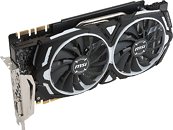- Joined
- Oct 9, 2007
- Messages
- 47,670 (7.43/day)
- Location
- Dublin, Ireland
| System Name | RBMK-1000 |
|---|---|
| Processor | AMD Ryzen 7 5700G |
| Motherboard | Gigabyte B550 AORUS Elite V2 |
| Cooling | DeepCool Gammax L240 V2 |
| Memory | 2x 16GB DDR4-3200 |
| Video Card(s) | Galax RTX 4070 Ti EX |
| Storage | Samsung 990 1TB |
| Display(s) | BenQ 1440p 60 Hz 27-inch |
| Case | Corsair Carbide 100R |
| Audio Device(s) | ASUS SupremeFX S1220A |
| Power Supply | Cooler Master MWE Gold 650W |
| Mouse | ASUS ROG Strix Impact |
| Keyboard | Gamdias Hermes E2 |
| Software | Windows 11 Pro |
MSI today launched the two other custom-design GeForce GTX 1080 Ti graphics cards apart from its Gaming X series, the GTX 1080 Ti Armor series, and the GTX 1080 Ti Aero series. Both lines further have variants that are factory-overclocked, and ones which stick to NVIDIA reference clock speeds. The GTX 1080 Ti Aero will be MSI's cheapest GTX 1080 Ti offering, which could sell on-par with NVIDIA's $699 Founders Edition SKU. It features a lateral-flow cooling solution that pushes hot air out of the case, much like the reference-design cooler. MSI improved upon the drab black plastic cooler shroud design of previous Aero series products with streaks of NVIDIA's favorite shade of green, which lends the card a Quadro-like appearance. The base GTX 1080 Ti Aero sticks to NVIDIA-reference clocks of 1480/1582/11000 MHz (core/GPU Boost/memory), while the OC variant ticks at 1506/1620 MHz, leaving the memory untouched.
The GTX 1080 Ti Armor series is a little more exciting. Part of MSI's Arsenal Gaming family, the Armor series cards are positioned between the Aero series and the Gaming X series. These cards feature an aluminium fin-stack heatsink that's ventilated by a pair of fans that spool down to zero when the GPU is idling. The card also appears to be using the same PCB as the GTX 1080 Ti Gaming X. The GTX 1080 Ti Armor sticks to NVIDIA-reference clock speeds, while the Armor OC variant does 1531/1645 MHz (core/GPU Boost) out of the box, which is a little behind the 1569/1683/11200 MHz the Gaming X ships with.





View at TechPowerUp Main Site
The GTX 1080 Ti Armor series is a little more exciting. Part of MSI's Arsenal Gaming family, the Armor series cards are positioned between the Aero series and the Gaming X series. These cards feature an aluminium fin-stack heatsink that's ventilated by a pair of fans that spool down to zero when the GPU is idling. The card also appears to be using the same PCB as the GTX 1080 Ti Gaming X. The GTX 1080 Ti Armor sticks to NVIDIA-reference clock speeds, while the Armor OC variant does 1531/1645 MHz (core/GPU Boost) out of the box, which is a little behind the 1569/1683/11200 MHz the Gaming X ships with.





View at TechPowerUp Main Site




 both sample (Armor/Gaming X) reached similar core clock speed and boost (my armor had a slightly higher sustained boost for a lower clock than a gaming X for some time )
both sample (Armor/Gaming X) reached similar core clock speed and boost (my armor had a slightly higher sustained boost for a lower clock than a gaming X for some time )
 the FE cooler is only a metal reference cooler (again) with a fancy name, ok ... for the backplate ... tho it's not that nice nor it add something to the card ( i didn't follow the fooler's edition saga ... does that backplate is made of metal also?
the FE cooler is only a metal reference cooler (again) with a fancy name, ok ... for the backplate ... tho it's not that nice nor it add something to the card ( i didn't follow the fooler's edition saga ... does that backplate is made of metal also?  )
) )
)

 then the Gaming X has only a backplate and TwinFrozr VI to value over the Armor, since, unlike the 1070 variante, no VRM/mosFET/PCIeX power are missing.
then the Gaming X has only a backplate and TwinFrozr VI to value over the Armor, since, unlike the 1070 variante, no VRM/mosFET/PCIeX power are missing.